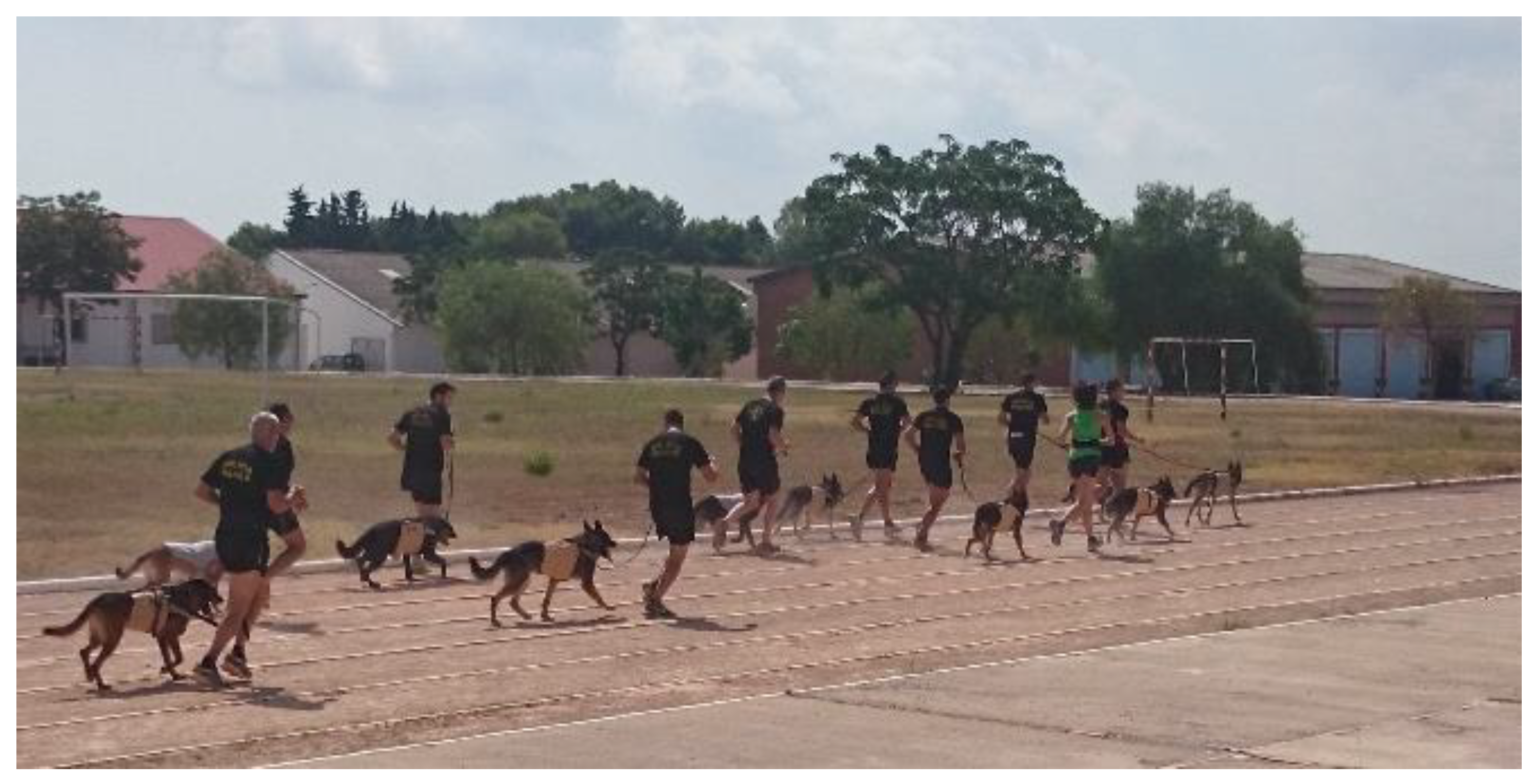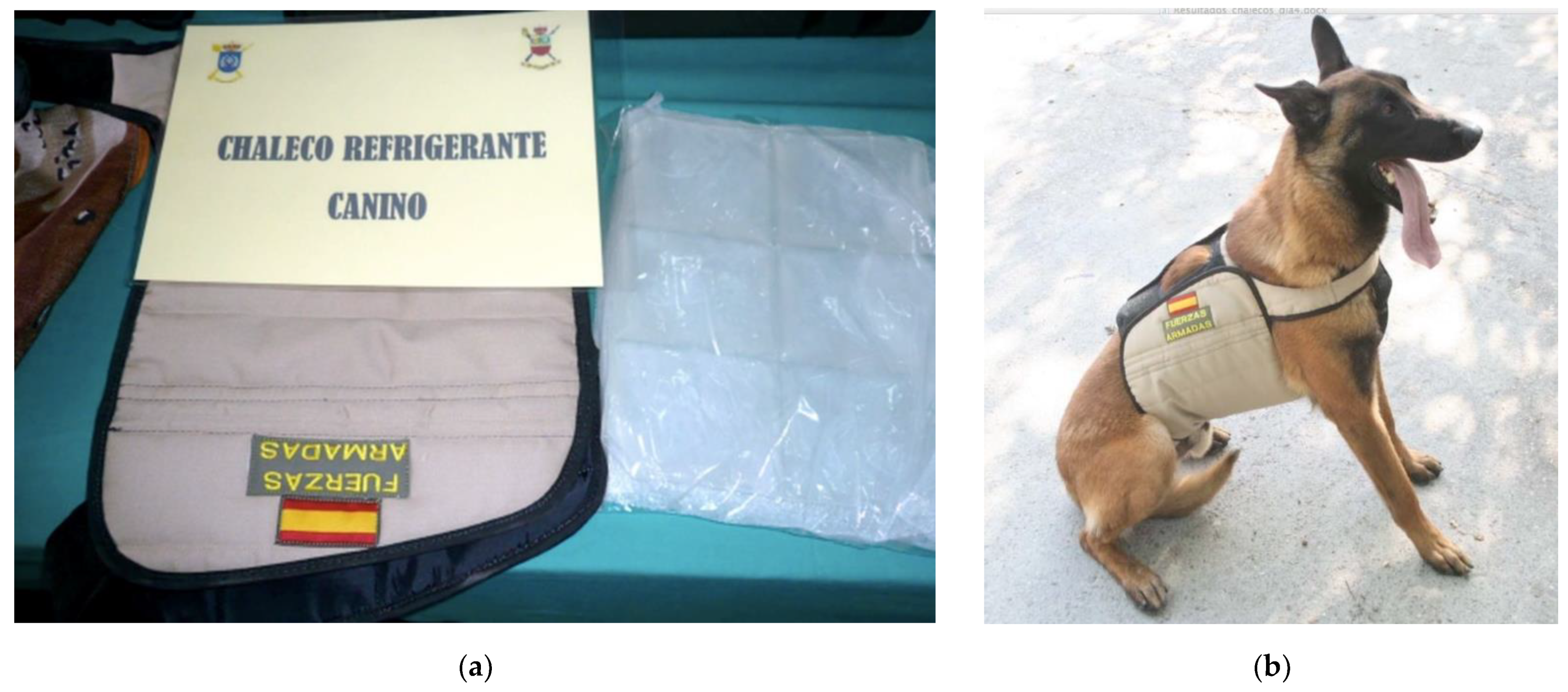3.3. Changes in Core Temperature Resulting from the Use or Non-Use of a Cooling Vest
A two-way repeated measures ANOVA 3 × 4 test was carried out, measuring the existence of temperature differences. The means and standard deviations in central temperature are shown in
Table 4, where we observed that the maximum temperature was 41.22 °C in the “without vest” condition, at the time of arrival. All dogs lowered their temperature 15 min after the end of the test. To know if these differences are due to the CONDITION factor, we performed a variance analysis.
First, we checked that the assumption of sphericity was met, using Mauchly’s test. In the analysis of the CONDITION factor and the CONDITION * MOMENT interaction, we accepted the null hypothesis, which leads us to believe that there is no violation of the assumption of sphericity and that the analysis of variance is adequate.
Given that, for the MOMENT factor, the assumption of sphericity is not met, the Greenhouse–Geisser test is probably the most appropriate value to use, although if we have relatively few participants it may tend to be too conservative (i.e., its use will decrease the chances of finding a significant result). You can see Mauchly’s test in
Table 5.
Thus, we obtained the following values for the factor CONDITION F (2, 24) = 6.927; p = 0.004; Partial Eta squared = 0.366. For the MOMENT factor we observed an F (1.2, 15.31) = 77.98; p < 0.001; partial Eta squared = 0.867. Finally, for the CONDITION × MOMENT interaction we obtained an F (6, 72) = 2.681; p = 0.021 and a partial Eta squared of 0.183.
We thus observed significant differences in each of the two factors as well as in the interaction between them with respect to the dependent variable body temperature. The partial Eta squared value provided us with the percentage of variance explained by each of the analyzed factors or by their interaction. Therefore, the factor that explained the greatest variance by itself was the moment, with 87% of the variance due to the factor itself.
Since the factors had more than two levels and showed significant differences, we proceeded to analyze the direction of these differences and between which levels they occured, applying the Bonferroni test (
Table 6).
Table 6 shows significant differences for the condition factor
p = 0.012; I−J = 0.427 between not wearing a vest and using Ev-CV, in the sense that there was a significantly lower body temperature when the dogs were wearing the vest.
Regarding the moment of temperature measurement, there were differences between all possible combinations, with the temperature always being lowest when the dogs were in the kennel and highest after exercise, as shown in
Table 7.
Without considering the CONDITION factor, we clearly observed, as expected, that temperatures increased with physical exercise, and these differences were for all the possibilities. We also observed that after fifteen minutes of recovery, the temperature decreased, to the point of being significantly lower than the temperature obtained at the finish line. The effect of wearing or not wearing a cooling vest will have to be determined to determine whether the interaction between cooling vest and momentum generates other differences.
Isolating the MOMENT, the analysis of the interaction effects showed significant differences at the time of arrival between not wearing a cooling vest and wearing the Ev-CV (
p = 0.011; I−J = 0.623). Lower temperatures were registered in dogs using the Ev-CV and 15 min after exercise between not wearing a cooling vest and wearing the PCM-CV (
p = 0.015; I−J = 0.492) and not wearing a cooling vest and using the Ev-CV (
p = 0.008; I−J = 0.769). In both interactions (
Table 8), on arrival, temperatures were always lower when wearing either of the two cooling vests versus no vest.
When we analyzed the interactions between CONDITION and MOMENT, we observed (
Table 9) the greatest number of significant differences occur. Thus when crossing the condition “without cooling vest”, we saw differences between all interactions except between taking the temperature without cooling vest in the kennel and taking the temperature without cooling vest at the start. The other five possible combinations showed the effects of exercise on temperature.
The same applies for the PCM-CV condition. No significant differences were found in the rectal temperature of the dogs that wore the PCM-CV in the kennel in relation to the moment of starting the race. Finally, in the condition of wearing the Ev-CV, significant differences occured in all six possible interactions.
3.4. Changes in Systemic Blood Pressure Resulting from the Use or Non-Use of a Cooling Vest
A two-way repeated measures ANOVA 3 × 4 test was carried out, measuring the existence of differences in systolic, diastolic, and mean arterial blood pressure.
Table 10 shows the average systolic, diastolic and mean arterial blood pressure, respectively.
In the case of systolic blood pressure, the assumption of sphericity was assumed for the CONDITION factor and for the interaction between factors, while no sphericity was assumed for the MOMENT factor. Thus, the corresponding F-values were: CONDITION F (2, 24) = 0.362; p = 0.700; MOMENT F (1.66, 19.87) = 1.092; p = 0.139; CONDITION × MOMENT F (6, 72) = 1.637; p = 0.150.
As for diastolic blood pressure, the assumption of sphericity was assumed in all circumstances, obtaining the following F-values: CONDITION F (2, 24) = 1.285; p = 0.295; MOMENT F (3, 36) = 1.953; p = 0.139; CONDITION × MOMENT F (6, 72) = 0.893; p = 0.505.
The F-values obtained for the mean arterial blood pressure, assuming sphericity were: CONDITION F (2, 24) = 0.490; p = 0.618; MOMENT F (3, 36) = 1.722; p = 0.180; CONDITION × MOMENT F (6, 72) = 1.000; p = 0.432.
As can be seen, in the case of systolic, diastolic and mean arterial blood pressure, there was no significance in any of the analyses we carried out. It seems that for this type of exercise (intensity and duration), blood pressure was not affected by any of the analyzed factors (condition and time) or their interaction.
3.5. Changes in Pulse Rate Resulting from Use or Non-Use of Cooling Vest
A two-way repeated measures ANOVA 3 × 4 test was carried out, measuring the existence of pulse rate differences. The means and standard deviations in pulse rate are shown in
Table 11, where the maximum registered pulse rate was 123 beats per minute in the “no waistcoat” condition at the time of arrival. Immediately afterwards (see
Table 11), we observed that all dogs lowered their pulse rate 15 min after the end of the test. As in the previous analyses, the analysis of variance allowed us to know if these differences were due to the CONDITION factor.
Once the sphericity test (
Table 12) was carried out, we accepted the assumption of sphericity for the CONDITION factor and for the interaction between the two factors.
However, with respect to the MOMENT factor, the assumption of sphericity was not met, so we used the F value of the Greenhouse–Geisser test, which is the most commonly used.
Thus, we obtained the following values for the factor CONDITION F (2, 24) = 1.011; p = 0.379; for the factor MOMENT we have an F (1.89, 22.64) = 19.817; p < 0.001; partial Eta squared = 0.623. Finally, for the interaction CONDITION × MOMENT we obtained an F (6, 72) = 1.284; p = 0.275.
In this case, there were significant differences with respect to the MOMENT factor, with 62% of the variance being explained by the effect of the time of measurement. As before, since the MOMENT factor had four levels and showed significant differences, we proceeded to analyse the direction of these differences and between which levels they occured, applying the Bonferroni test, whose results are shown below in
Table 13.
With regard to the dependent variable pulse rate, significant differences were obtained for the MOMENT factor. As it had four levels, the differences between pairs were carried out, obtaining the following results.
Differences were found between the pulsations in the kennel and on arrival p < 0.001; I−J = −32.359. Likewise, differences were also found in the pulsations on departure versus arrival p = 0.004; I−J = −28.256. Finally, differences were also found between pulsations on arrival and post-exercise rate pulse p < 0.001 I−J = 20.487.
Finally, with regard to the effects obtained in the interaction when isolating the condition variable, the significant differences appeared, whose values are shown in
Table 14.
As can be seen, the effect of the cooling vest hads its benefits, since, when the dogs wore the Ev-CV, the reduction in heart rate (pulse) at arrival and 15 min post-exertion was statistically significant, whereas the dogs wearing the PCM-CV showed no statistically significant differences in pulse rate recovery.











